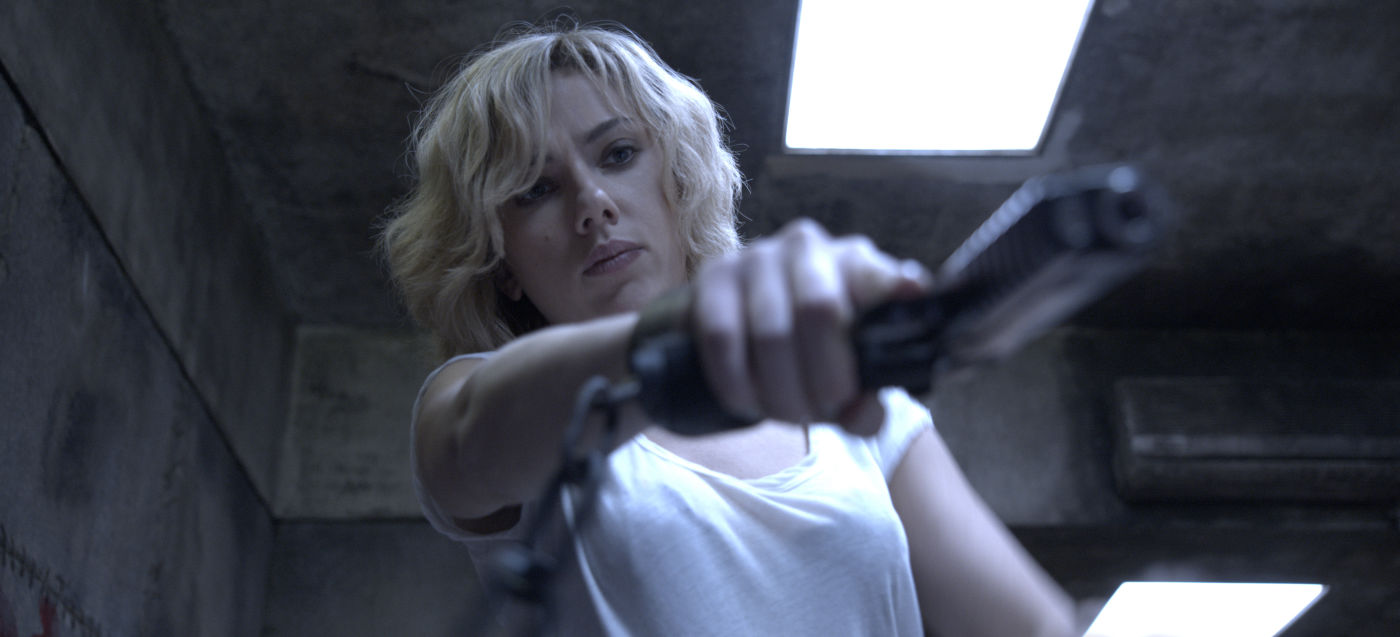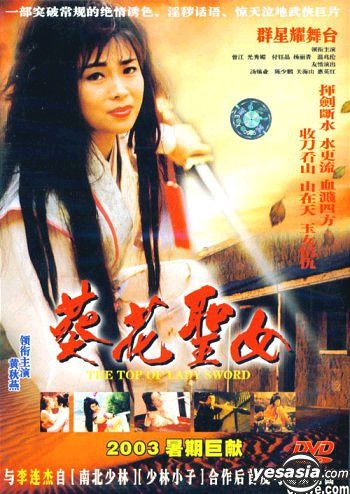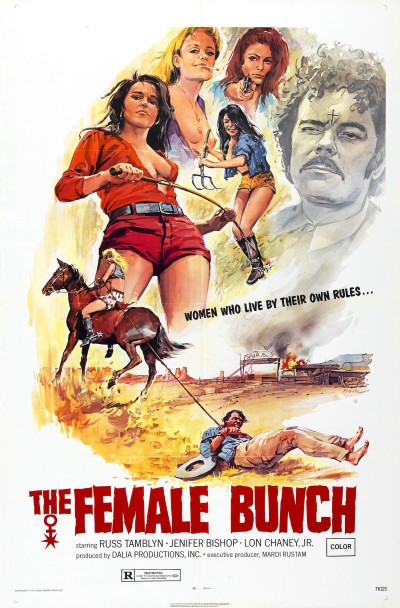Kristanna Loken, Brigitte Nielsen, Vivica A. Fox, Cynthia Rothrock, and Zoë Bell?
Why was I not informed of this? It’s out August 8, on video and VOD. Needless to say, a review will follow here very, very quickly.
Actress Rina Takeda is well known around GirlsWithGuns.org, for her work in films like Karate Girl, and got the chance to throw out the first pitch before a game in Japan between the Chiba Lotte Marines and the Saitama Seibu Lions. Of course, Takeda did it with her own inimitable style: first breaking 10 cement blocks with her head!
 Zoe (Adrienne) is driving across country to meet her long-distance boyfriend, Dane (Samuel), when she has the misfortune to stumble into a pack of four rednecks, engaged in their favourite pastime of hunting the local Indians. When they stab one to death right in front of her, it’s clear things are going to end badly for her: and they do, as she is raped, brutalized and left near-dead in a shallow grave. But a conveniently-passing shaman finds her; though his efforts to save her are unsuccessful, the spirit of a dead chief enters Zoe. For, it turns out, he was killed by the ancestors of these same rednecks, and he sees in Zoe the chance to extract his long-awaited and brutal revenge. However, there’s a time-limit involved: since she’s still technically dead, decomposition is setting in…
Zoe (Adrienne) is driving across country to meet her long-distance boyfriend, Dane (Samuel), when she has the misfortune to stumble into a pack of four rednecks, engaged in their favourite pastime of hunting the local Indians. When they stab one to death right in front of her, it’s clear things are going to end badly for her: and they do, as she is raped, brutalized and left near-dead in a shallow grave. But a conveniently-passing shaman finds her; though his efforts to save her are unsuccessful, the spirit of a dead chief enters Zoe. For, it turns out, he was killed by the ancestors of these same rednecks, and he sees in Zoe the chance to extract his long-awaited and brutal revenge. However, there’s a time-limit involved: since she’s still technically dead, decomposition is setting in…
There are a couple of interesting wrinkles here, first that Zoe is deaf. This disability doesn’t play much part in proceedings, which is actually kinda cool: it’s just another aspect of her character. What is rather more relevant, is that Dane is black, so when he heads out in search of her, and crossed the path of the rednecks, it soon becomes very apparent that it isn’t just native Americans they dislike. All of which simply adds impetus to your enthusiasm for them to get their comeuppance, and that certainly happens. The “revenge” part of this rape-revenge flick starts with the possessed Zoe in a bar, yanking someone’s intestines out like they were tickets from an arcade game, and impressively, somehow manages to escalate from there. She gets to wield a variety of traditional weapons, such as a bow & arrow or spear, on the way to the slightly-less traditional tomahawk vs. chainsaw finale.
This only comes close to working if you don’t think about it too much: ideally, at all. Otherwise, you’ll be left wondering about questions like why the shaman didn’t do the sensible thing and call 911; too often, the supernatural aspects are used as an alternative for plot logic. Have to say, though, Adrienne is very good as Zoe, though in some ways, it’s a shame she has to be possessed by a male ghost to get her revenge. I’d have been perfectly happy for her to be intestine-yanking on her own terms, and Dane could also be excised from the plot entirely. Still, the further this heads into excess e.g. point-blank target practice, the more entertaining it is, and the practical effects are more than good enough to counter some distinctly ropey CGI work. As the title of this piece suggests, more than one review has compared this to The Crow – and that’s a reasonable parallel, considering its similar mix of soft-core spirituality and hard-core violence.
Dir: Michael S. Ojeda
Star: Amanda Adrienne, Tom Ardavany, Ronnie Gene Blevins, Marc Anthony Samuel
 The extraordinarily surly teenager Elizabeth (Ronan), who loudly insists on being known by everyone as “Daisy,” is sent from American to spend the summer in rural Britain with relatives. Unsurprisingly, she hates it – at least, until she meets Eddie (MacKay), a local brooding hunk for whom she falls. Fate throws a spanner in the works, however, as escalating tensions eventually lead to a nuclear attack on London and the outbreak of World War 3, against an un-named foe. The kids try to fend for themselves, but the boys and girls are forcibly separated, with Daisy having to take care of young cousin Piper (Bird). Turning her willpower to topic other than, as she says, not eating chocolate, she and Piper escape the camp where they are being used as forced labour, and begin the hazardous trek back to where Daisy is sure Eddie is waiting.
The extraordinarily surly teenager Elizabeth (Ronan), who loudly insists on being known by everyone as “Daisy,” is sent from American to spend the summer in rural Britain with relatives. Unsurprisingly, she hates it – at least, until she meets Eddie (MacKay), a local brooding hunk for whom she falls. Fate throws a spanner in the works, however, as escalating tensions eventually lead to a nuclear attack on London and the outbreak of World War 3, against an un-named foe. The kids try to fend for themselves, but the boys and girls are forcibly separated, with Daisy having to take care of young cousin Piper (Bird). Turning her willpower to topic other than, as she says, not eating chocolate, she and Piper escape the camp where they are being used as forced labour, and begin the hazardous trek back to where Daisy is sure Eddie is waiting.
The best thing here by far is the heroine’s character arc. In the first two minutes, it’s established what a totally unlikeable bitch Daisy is: she has clearly made up her mind to hate the trip and everything about it, and the audience hates her for the obvious narcissism. But by the end, she has been forged in the fire of adversity and completely transformed in just about all aspects of personality, to someone who has learned that it’s much better to live your life for others than for yourself. As Chris noted, it’d be funny if the whole thing had just been a set-up by her (unseen) father, just to teach his whiny daughter a good lesson. That isn’t the case: what it is, is another powerhouse performance by Ronan, backed by solid work from the rest of the young cast, particularly Piper, who could gives the likes of Abigail Breslin and Dakota Fanning a run for their money in the Adorability Stakes.
Probably the main weakness is the abruptness of the relationship between Daisy and Eddie. It probably needed more time taken to develop it, because as things stand, it seems Daisy falls head over heels for him at about the second glance. On the other hand, I’m quite glad it didn’t because it’s the kind of standard, young adult cliché which we’ve seen far too often before [this was based on a book from the genre by Meg Rosoff]. Much more satisfying is the second half, when Daisy is forced entirely into relying on her own skills, and becomes a much more interesting character as a result. Director Macdonald got his start in documentary film-making and brings much of the same urgency to proceedings here, not soft-pedalling the brutality and violence of armed conflict. Like a more contemporary version of The Hunger Games, it shows how inner strength can be found in the most surprising of places, and Ronan cements her position as one of the leading young action heroines in Hollywood.
Dir: Kevin Macdonald
Star: Saoirse Ronan, George MacKay, Harley Bird, Tom Holland
 Break out the bunting, because we have the first bona-fide action heroine movie of 2014 to top the US box-office. Luc Besson’sSF flick Lucy, starring Scarlett Johansson, crushed both projections and the competition, opening with an estimated $44 million over the weekend. It’s the first “true” action film led by an actress to take the #1 spot since The Hunger Games: Catching Fire spent two weeks there in November and December last year. [Unless you count 300: Rise of an Empire, and though we reviewed it here, the female presence there was as an antagonist more than the protagonist. Though on further review, maybe Maleficent should also be considered?]
Break out the bunting, because we have the first bona-fide action heroine movie of 2014 to top the US box-office. Luc Besson’sSF flick Lucy, starring Scarlett Johansson, crushed both projections and the competition, opening with an estimated $44 million over the weekend. It’s the first “true” action film led by an actress to take the #1 spot since The Hunger Games: Catching Fire spent two weeks there in November and December last year. [Unless you count 300: Rise of an Empire, and though we reviewed it here, the female presence there was as an antagonist more than the protagonist. Though on further review, maybe Maleficent should also be considered?]
This is a great result for both Johansson and Besson. To take the latter first, his previous best-performing picture in North America was The Fifth Element which grossed the equivalent of $113.3 million in inflation-adjusted dollars, when it came out in 1997, with an opening weekend of about $30.2 million, again inflation-adjusted. It’s also Johannson’s best performance outside of the Marvel universe, beating out 2009’s He’s Just Not That Into You, which bowed in 2009 to $27.8 million. It’s miles ahead of other original action-heroine works, such as Colombiana ($10.4 million) or Haywire ($8.4 million). as first weekends go, it slots in at #6 all time for our genre, behind two Hunger Games films, another pair of adaptations in Divergent and Tomb Raider, and the Jolie/Pitt vehicle Mr. and Mrs. Smith. Speaking of Angelina, it’s slightly ahead of Salt, though that was better reviewed, and likely will possess better legs at the box-office.
 Still, somewhere around $125 million in the US is likely, which would give it a place in the all-time top 10 for GWG flicks – and likely twice as much overseas. Considering it cost only $40 million in total, one imagines the possibility of a sequel is already being pushed around the drawing board. It’s particularly impressive for Lucy to come out on top of Hercules, which cost about 2.5 times as much and had a well-established action name front-lining it, in Dwayne Johnson. It also had more venues and 3D ticket pricing on its side. Of course, with Guardians of the Galazy opening on Friday, this is certain to be a one-weekend wonder, but with Lucy having taken in more than its entire budget in just three days, I doubt anyone involved will mind too much. For now, I guess Scarlett Johansson just kicked The Rock’s ass. :)
Still, somewhere around $125 million in the US is likely, which would give it a place in the all-time top 10 for GWG flicks – and likely twice as much overseas. Considering it cost only $40 million in total, one imagines the possibility of a sequel is already being pushed around the drawing board. It’s particularly impressive for Lucy to come out on top of Hercules, which cost about 2.5 times as much and had a well-established action name front-lining it, in Dwayne Johnson. It also had more venues and 3D ticket pricing on its side. Of course, with Guardians of the Galazy opening on Friday, this is certain to be a one-weekend wonder, but with Lucy having taken in more than its entire budget in just three days, I doubt anyone involved will mind too much. For now, I guess Scarlett Johansson just kicked The Rock’s ass. :)
But was it any good? You’ll have to wait for our review to find out…

 Following on more or less directly from the events of the first part, this sees Maki the Lone Wolf seeking revenge for the death of Midori as she fought against the principal and his reign of terror. Now in charge is Ranko and her gang, who stepped in to occupy the power vacuum, to “keep peace and good order” in the school – along with hunting down the remnants of Midori’s faction. Ranko captures Maki, but our heroine escapes with the unwitting help of Chiaki, one of Ranko’s Demons, and joins Momonga and Third, the last girls standing of Midori’s gang. Chiaki also allies herself with them, knowing Ranko will blame her for Maki’s escape. But can she really be trusted? And can Maki defeat, not only Ranko, but the hardcore delinquents she has recruited to join her, the very worst drawn from schools across Japan: Rakish O-Gin, Kiriko the Praying Mantis and Rinka the Parasol.
Following on more or less directly from the events of the first part, this sees Maki the Lone Wolf seeking revenge for the death of Midori as she fought against the principal and his reign of terror. Now in charge is Ranko and her gang, who stepped in to occupy the power vacuum, to “keep peace and good order” in the school – along with hunting down the remnants of Midori’s faction. Ranko captures Maki, but our heroine escapes with the unwitting help of Chiaki, one of Ranko’s Demons, and joins Momonga and Third, the last girls standing of Midori’s gang. Chiaki also allies herself with them, knowing Ranko will blame her for Maki’s escape. But can she really be trusted? And can Maki defeat, not only Ranko, but the hardcore delinquents she has recruited to join her, the very worst drawn from schools across Japan: Rakish O-Gin, Kiriko the Praying Mantis and Rinka the Parasol.
This is definitely better than the predecessor, mostly because it focuses on Maki. As noted in my previous review, she did a better job of capturing the pinky violence attitude than Midori, and we see that again here – the spirit of Midori shows up to guide Maki at various points, and the difference in their performances is obvious. There’s also more going on in terms of storyline and characters. Chiaki has a subplot about an ailing sister who yearns to see Chiaki become successful, and Ranko’s henchwomen are memorable villains in themselves. In particular, Rinka is a pitch-perfect Gothic Lolita, all frilly dresses and dark eyeliner, but carrying an umbrella which is also an automatic weapon. As the onlookers say while she’s fighting Maki:
A machine-gun parasol? Is she really just a schoolgirl?
She is majoring in technical subjects...
It’s also impressively gynocentric, with little or no male roles whatsoever, and the ones present are little more than drooling, sex-mad imbeciles, easily exploited for the benefit of the female characters.
I think it’s perhaps less obviously a parody, and that works in its favour. Not that it’s any less subtle; for example, early on, Maki’s method of attack is entirely focused on ripping open the tops of her adversaries. But rather than driving the joke into the ground, the makers let it go, and her fights against the higher-level minions are much closer to what you saw in the seventies. You don’t need to have seen part 1 to follow the story here, and the movie even works on its own, rather than requiring significant previous knowledge of the genre. It may be forty years late, but it’s one of the most-entertaining pinky violence films I’ve seen.
Dir: Toshiya Kominami
Star: Akari Asahina, Yoko Fujimura, Saya Kobayashi, Aoi Hozumi
 What were you doing when you were 14? Going to school. Hanging out with friends. Being highly irritated by your parents. That’s probably fairly close. I’m quite sure the answer isn’t “spending two years sailing around the world by yourself.” Which would be Laura Dekker’s answer. The film chronicles her single-handed sailing expedition, as well as the path of her life which led her to the epic voyage, and the battle against the Dutch government, who considered the trip dangerous, and wanted to remove Laura from parental custody as a result. [That aspect reminded me of Ready to Fly, where the women ski-jumpers also had to go to court as part of their battle for acceptance]
What were you doing when you were 14? Going to school. Hanging out with friends. Being highly irritated by your parents. That’s probably fairly close. I’m quite sure the answer isn’t “spending two years sailing around the world by yourself.” Which would be Laura Dekker’s answer. The film chronicles her single-handed sailing expedition, as well as the path of her life which led her to the epic voyage, and the battle against the Dutch government, who considered the trip dangerous, and wanted to remove Laura from parental custody as a result. [That aspect reminded me of Ready to Fly, where the women ski-jumpers also had to go to court as part of their battle for acceptance]
The bulk, however, is about the trip itself, with the on-board footage all filmed by Dekker herself, for obvious reasons connected to the word “single-handed” – fortunately, my fears of sub-Blair Witch shakycam proved unfounded. The main problem is the almost complete lack of any drama here. Maybe there’s more if you are a sailing enthusiast, but about as exciting as it gets, is a bit of rough weather and a bird that takes refuge on the deck. The only narrative tension is Laura’s decision to switch from sailing under the Dutch flag to that of the country where she was born (on a boat), New Zealand. I appreciate that you can’t manufacture drama where none happened, but this seems less like the taxing and potentially lethal endeavour it would seem to be, and more like a jaunt around a village pond on a slightly-overcast Saturday afternoon. One bit of ocean blends into another, and perhaps the most interesting parts are during Dekker’s sometimes lengthy stopovers en route, where she explores the local landscape.
Dekker herself generally comes over as remarkably mature for her age – 14 when she started, 16 by the time she completed the circumnavigation – albeit occasionally a bit bratty. That’s perhaps exacerbated by her basically fending for herself for two years, though if you’ve raised a teenage girl, you’ll know that’s pretty much par for the course, and any self-centredness is backed by an ability to handle whatever the world throws at her, well in excess of that possessed by a normal adolescent. However, nor is there much sense of character development, and you don’t get any sense the Laura you see at the end was changed in any significant way by her experience. The film definitely needs to dig deeper into what makes Dekker tick, and the apparent failure to do so, leaves it as not much more than a shallow, if pretty, travelogue. The heroine deserves a bit better.
Dir: Jillian Schlesinger
Star: Laura Dekker
 This Taiwanese production focuses on a martial arts get-together, organized by the honorable Chi (Tsang), as a way for all the local artists to settle any beefs with each other. Arriving in town are brothers Au Lung and Wong Hu (Wan), who are out for revenge on Lady Yung (Wong), who had killed another of their brothers, though it was actually an honourable battle. Au Lung is content to forget their revenge, until he falls under the spell of a local inn-owner, who has a plan to seduce him, and use Au Lung as a tool to steal Chi’s martial arts manual and become the top fighter. When Chi turns up dead, Yung is blamed, and after that is sorted out, her husband and daughter as then kidnapped by Au Lung. Yung, her sister Shao Chung (Khan) and Wong Hu set off in a desperate effort to rescue the hostages.
This Taiwanese production focuses on a martial arts get-together, organized by the honorable Chi (Tsang), as a way for all the local artists to settle any beefs with each other. Arriving in town are brothers Au Lung and Wong Hu (Wan), who are out for revenge on Lady Yung (Wong), who had killed another of their brothers, though it was actually an honourable battle. Au Lung is content to forget their revenge, until he falls under the spell of a local inn-owner, who has a plan to seduce him, and use Au Lung as a tool to steal Chi’s martial arts manual and become the top fighter. When Chi turns up dead, Yung is blamed, and after that is sorted out, her husband and daughter as then kidnapped by Au Lung. Yung, her sister Shao Chung (Khan) and Wong Hu set off in a desperate effort to rescue the hostages.
There’s a lot to enjoy here, and about the only thing stopping it from getting a seal of approval is that it’s very wuxia – so if you’re not fully prepared for people flying through the air and severely undercranked action, this will seem laughable. It’s one of those occasions where less could have been more. But, personally, I still found it a great deal of fun, with a well thought-out plot, engaging characters and some nice twists on the usual themes. For instance, there’s a lovely bit of role reversal, where it’s Yung’s husband who is the stay at home one, and she is running around the countryside, fighting battles against, it seems, everyone who crossed her path. Additionally, I liked the brief diversion into almost a kung-fu “whodunnit” in the middle, and on the other end of the emotional spectrum, there’s a body-count which is surprisingly high. If I don’t want to spoiler who lives and who dies, let’s just say there’s more of the latter.
The bottom line, however, is the martial arts, and these sequences are copious and well-staged, under action coordinator Alan Chan. The various performers get to showcase a broad variety of their styles, and they mesh together well. Everyone gets their moments to shine, will all three of the leading ladies looking very impressive. This one is available on Youtube with subtitles, and even if the quality of the print leaves a fair bit to be desired, it still makes for an entertaining 90 minutes, and is a case where a film’s obscurity is no reflection of its merits.
Dir: Wong Hong
Star: Wong Chau-Yin, Deric Wan, Kenneth Tsang, Cynthia Khan
a.k.a. Lady Chrysanthemum Sword
 It’s important to realize that you need to be familiar with the pinky violence genre that this lovingly replicated and parodies, in order to get the most from it. If not, this will seem over-wrought, incredibly over-acted and more than slightly ridiculous, not least in the way that bras are apparently an unknown item in Japan. But, if you’ve seen enough of the movies that inspired it, you will appreciate from where it’s coming.
It’s important to realize that you need to be familiar with the pinky violence genre that this lovingly replicated and parodies, in order to get the most from it. If not, this will seem over-wrought, incredibly over-acted and more than slightly ridiculous, not least in the way that bras are apparently an unknown item in Japan. But, if you’ve seen enough of the movies that inspired it, you will appreciate from where it’s coming.
“I make my formal greeting. I was born and raised in Chicken Valley. My father was a poultry farmer. From age seven, I slaughtered chickens, 444 in total. By name I am Red Malice, Yumi the Cockscomb.”
Yeah, it’s like that. The heroine, Midori – a.k.a. Invincible Midori, the Wild Chrysanthemum – used to be a big shot, but now just wants the quiet life for her and her friends at her school, even though she could run it if she wanted. “It’s a mess, what’s the point? This way, I can do what I want,” Midori says. But, as you can imagine, she isn’t left in piece. For instance, there’s Maki, who has been trying to defeat Midori since they were both children. But worse still is Ranko and her Demon Gang, who operate as the strong arm of the principal and pimp unwilling members of this fine educational establishment out to his lecherous friends. There’s an uneasy truce between Ranko and Midori, but that is shattered after Harue seeks protection from the former, and her plight reminds Midori of exactly why she dropped out of the gang business.
From there, things escalate in the way they usually do, with Midori honey-potting a politician and the principal, then using the photographs to foment rebellion among the other students. However, the principal retaliates by turning to his brother, head of the Inagaki Gang, who retake the school while Midori is busy dealing with Maki, setting up the final, explosive battle. In other words, it’s basically a pastiche, gluing together the tropes familiar from just about any example in the field, and turning the dial on them all, just a little bit higher. Most obviously, it’s almost de rigeur in the originals for the heroine’s top to be ripped open when she fights. Here, with refreshing honesty, that’s virtually the opening move. The main weakness is probably the lead (Hoshimi, I think – though since this doesn’t appear to have an IMDb entry, I’m kinda guessing), who is kinda bland and colourless, especially beside the actresses playing Maki and Ranko. This is the kind of thing where the performers need to throw all inhibition out the window: when that happens, you can certainly see where they’re going. However, it only happens intermittently, rather than with the consistency necessary to be truly successful.
Dir: Toshiya Kominami
Star: Rika Hoshimi, Asuka Misugi, Saya Kobayashi, Yoko Fujimura
 Despite a title which seems to be echoing a certain Sam Peckinpah film, this is a Western only in location, being set firmly in the present day. Las Vegas waitress Sandy (Renet) tries to kill herself after being dumped yet again, and a friend introduces her to the gang of women led by Grace (Bishop), who occupy a ranch in the desert near the Mexican border, take no shit from any man and ride across the border to a town to blow off steam when necessary. This also lets Grace pick up drugs which she both sells and uses. The only rule is no men on the ranch, except for Monti (Chaney), a former stuntman devoted to Grace. When that gets broken, the man responsible is branded on the forehead as a warning, which sets in motion a train of events that end where the film begins – with Sandy and another man, driving through the desert, trying to escape from the pursuing banshees.
Despite a title which seems to be echoing a certain Sam Peckinpah film, this is a Western only in location, being set firmly in the present day. Las Vegas waitress Sandy (Renet) tries to kill herself after being dumped yet again, and a friend introduces her to the gang of women led by Grace (Bishop), who occupy a ranch in the desert near the Mexican border, take no shit from any man and ride across the border to a town to blow off steam when necessary. This also lets Grace pick up drugs which she both sells and uses. The only rule is no men on the ranch, except for Monti (Chaney), a former stuntman devoted to Grace. When that gets broken, the man responsible is branded on the forehead as a warning, which sets in motion a train of events that end where the film begins – with Sandy and another man, driving through the desert, trying to escape from the pursuing banshees.
There’s an aura of Faster, Pussycat here, with a roaming gang of women, outside the law and terrorising anyone unfortunate enough to cross their path – here, the most obvious victim (except for the branded guy) is a poor Mexican who sets up house on the trail they use to cross the border. However, it’s the opposite sex – and the treatment thereof – which ultimately leads to their downfall. Certainly, I can see echoes of Varla in Grace, though Bishop is a mere fraction of Tura Satana, and that’s probably the film’s main weakness – as the axle round which the wheel turns, she doesn’t have the presence to make for a believable “queen bee,” to whom others gravitate. However, it’s undeniable she’s a dark anti-hero, with the film not stinting at all from depicting her intravenous drug use, and it’s refreshing to see a film with such a flawed character at its focus.
Some bits of trivia worth noting. This was subsequently released in some territories on a double-bill with Ted V. Mikel’s vaguely similarly themed, but vastly inferior, The Doll Squad. Lon Chaney Jr’s last film before he died, and his voice is incredibly raspy – perhaps a relic of his battle with throat cancer. Though Adamson denies it, many sources say that some footage for this was apparently shot at the Spahn Ranch, later to be home to the Manson family, while they carried out the Tate-LaBianca murders – the movie was released the same month authorities raided the ranch. I’m sure any similarity to this story, of a gang held together by its charismatic leader, until it disintegrates in a killing spree – not to mention the guy with a cross etched into his forehead! – is purely coincidental. But it’s decidedly spooky, none the less.
Dir: Al Adamson
Star: Jenifer Bishop, Nesa Renet, Lon Chaney Jr., Geoffrey Land